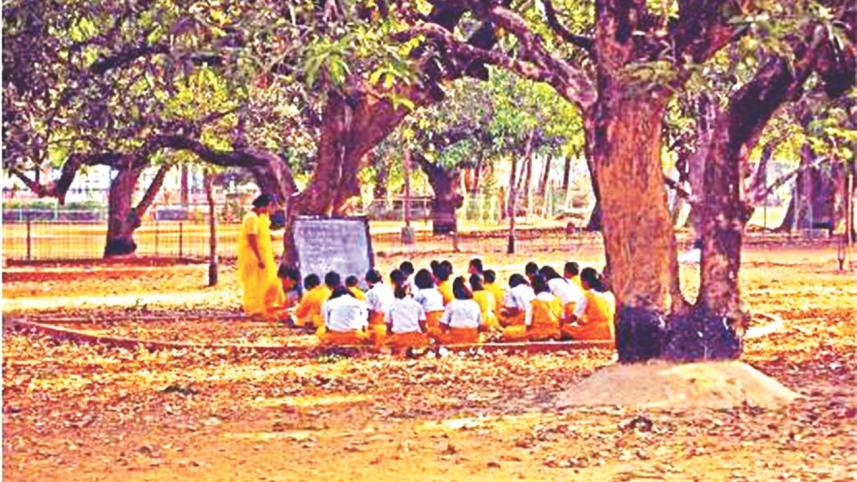Where the world makes a home in a nest

Tagore's cultural epicentre Shantiniketan offers an artistic assembly of bauls, urban artistes, classical artistes, academics and many more. Perhaps no other university has had such an integral ethnic component and cross-cultural assimilation during the colonial period. Tagore's experiment greatly influenced educational experimentation worldwide.
Tagore was a 'free spirit in movement' and emphasised endless learning. In 1901, the bard started a school at Shantiniketan named “Brahmachari Ashram”, modelled on the lines of the ancient Gurukul system. It later came to be known as the Patha Bhavan, with the idea that learning in a natural environment would be more enjoyable and fruitful.
With financial backing of the Maharaja of Tripura, the Visva-Bharati Society was established in 1921. Tagore envisioned a centre of learning combining the best of both East and West. The school was expanded into a university named Visva-Bharati, which was defined by Tagore as “Where the world makes a home in a nest.” The open-air education as opposed to confinement within the four walls of a classroom became a reality here.
Tagore envisioned the festivals as a celebration of diversity that united all. For him it was to be cluster of events in which individuals and groups from all sections of the society would come together. Festival therefore represented a holistic celebration of the whole of human society, which presented the opportunity for shared aesthetic experience and creativity.
The festivals of nature welcome everyone to participate under the canopy of the trees, the blue expanse of the sky, in the soft sunlight and in an air redolent with fragrance of blossoms. The nuances of seasonal changes in Shantiniketan beckon festivals. The monsoon arrives with a special appeal; the singing of cuckoos declares the onset of spring while the cool air hints of autumn. Various festivals revolve around the seasons.

Tagore therefore organised festivals in Shantiniketan heralding different seasons. The celebration of the seasons through songs, dance and fairs became a regular event in the Shantiniketan calendar. The Barshamongol would be observed to celebrate the advent of the rains, Sharad Utshab to celebrate autumn, Poush Mela to celebrate winter, Bashonto Utshab to celebrate spring and finally Pahela Boishakh celebrating the Bengali New Year.
Rabindranath's familiarity with the Bengal monsoon intensified during his trips to the family estate at Shilaidaha. The vast landscapes and the swirling rivers seemed to foster a sense of liberated creativity in close proximity with nature. Monsoon, for Tagore, was not merely a personal experience; it was a symbol of life and nature's amazing variety; a message that he sought to transmit to his students through the festival of Barshamongol. The educational programme at Santiniketan was thus deeply rooted in an ecological consciousness.
While the Bashonto Utshab, observed on the full moon night of the spring, coinciding with Holi or the festival of colours, would be the most spectacular and aesthetic of all festivals, the most important event from all accounts would be the Bengali New Year celebration which would be celebrated on the first day of Baishakh along with bard's birthday.
In addition to these, Tagore would also introduce with great beauty and splendour, special commemorative events like brikkho ropon (tree planting) as a part of an annual environmental awareness campaign. Many ethnic groups who lived in and around Shantiniketan were invited to be part of these celebrations.
All these festivals give a very strong feeling uniting all in diversities. Not only did these festivals bring people together, they also encouraged the arts, particularly rural artisans, who would sell their goods in the adjunct fairs. There would also be a lot of feasting circling these events.
Tagore composed a large number of songs, plays and poems specifically for these occasions and more often than not sang and performed in plays during these festivals.




 For all latest news, follow The Daily Star's Google News channel.
For all latest news, follow The Daily Star's Google News channel.
Comments